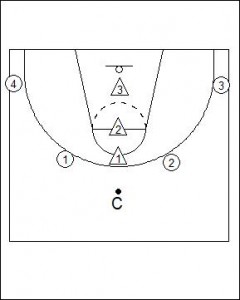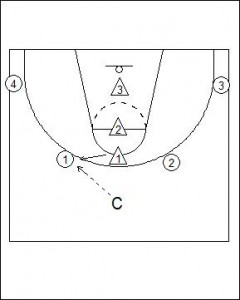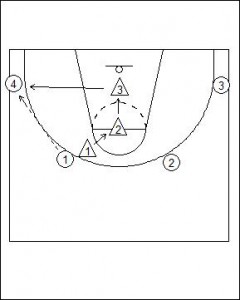Home, Top and Ball Drill Fab 5
The Home, Top and Ball Drill is a 3 vs 4 half-court man to man defensive build up drill in the FAB 5 series. When instructing in the tactical areas of half-court man to man defence it is important to have a range of drills that build upon areas such as player numbers and teaching points.
The Home, Top and Ball Drill builds upon the 2 person defensive rotation drills discussed earlier. By adding the additional player this creates additional bodies in the confided space of the keyway which has the potential for collisions and more reactive opportunities to incorrect rotations. The ability for a player to develop the automatic knowledge of where to move to is one thing, creating a player who is able to think and react in situations and choose the best option, even if it is different to the desired rotation is another.
As an example a player who should be covering the split line position incorrectly fills a different help position off the ball. What should his or her teammates do? They should of course break the standard to rotation to fill the vacant pivotal position. But many times over and over again we seen basketball athletes react with robotic efficiency instead of taking the calculated and key decision. Think about how many times this happens in games you are coaching or watching where one extra rotation even though “it is not your man” would result in stoping an offensive play.
For the Home, Top and Ball Drill focus on the following points:
- Good communication; help defenders must communicate to help with rotations and filling the gaps
- Close-out and fill help positions at pace; sprint to a spot. As players become more confident and are pushed they can start to also communicate on the run to speed up the effectiveness of their rotations
- Vision of the offensive players is vital; when on the split line the defensive player should see everyone and because of this they must communicate well
Communicate with purpose; as your players become more and more familiar with rotations and become more confident in what they need to do. Build in the specific verbal cues you want your players to use. Each coach has their own preferences on what they want communicated, just remember that players communicating in sentences makes them tired and limits their oxygen intake.

Coach starts with the ball at point position.
Four offensive players line the perimeter of the three point line.
Three defensive player’s line-up on the split-line, in defensive stance. These three players have positions, One (1) is Ball, Two (2) is Top and three (3) is Home.
Defensive players rotate depending on the movement of the ball and who is the closest. Players must also call out their position and what spot they are filling; Home, Top and Ball.
Drill starts with coach passing ball to any offensive player.

In this scenario the ball is passed to one of the offensive players in the guard positions.
Defensive player One (1) moves to the ball calling “Ball”. Two (2) holds position calling “Top”, and three (3) holds position calling “Home”.

Offensive player One (1) passes ball to four (4).
Defensive player Three (3) rotates to offensive player Four (4) calling “Ball”. Two (2) rotates to split-line in front of basket calling “Home”, and One (1) rotates to free-throw line calling “Top”.
In this development drill the core theme is “there are no excuses”, players must rotate or the defence will not succeed in its task.
To help with the rotations as a basic defensive principle when the ball is passed to any player below the broken circle, the Home player must take the “Ball” position.
Another defensive rotation principle is the player on the ball can never move to the ball position in the next phase. The top player must rotate to take the ball position. This eliminates players just shifting from one ball handler to the next. This also forces the three defensive players to be in constant motion and develop their ability to think with multiple decision inputs.
Want more? Follow our series development as well look at drills developing individual (technical) and team (tactical) skills for teaching and instructing in defensive principles.
The Fab 5 Drills Series is a grouping of drills selected to underpin basic skill instruction for the use by coaches at all levels featuring technical and tactical elements from both offensive and defensive situations.






Leave a Reply